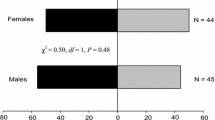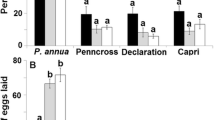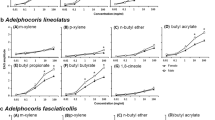Abstract
A dual-choice olfactometer was developed to study the responses of sweet potato weevils,Cylas formicarius elegantulus (Summers), to volatiles from the sweet potato,Ipomoea batatas (L.) Lam. Both males and females were attracted by volatiles from sweet potato leaves and a methylene chloride leaf extract. Females, but not males, responded to volatiles from storage roots and a methylene chloride root extract. Leaves and storage roots from four sweet potato cultivars (Centennial, Jewel, Resisto, and Regal) were attractive to female weevils; however, the attractant response varied with cultivar. GC profiles from leaf and root extracts, and GC-MS analysis of leaf extract, for Jewel cultivar enabled the volatile peaks to be identified as sesquiterpenes.
Similar content being viewed by others
References
Arrendale, R.F., Severson, R.F., andChortyk, O.T. 1984. Open split interface for capillary gas chromatography/mass spectrography.Anal. Chem. 56:1533–1537.
Cockerham, K.L.,Deem, O.T.,Christian, M.B., andNewson, L.D. 1954. Biology of the sweet potato weevil.La. Agric. Exp. Stn. Tech. Bull. 483:30 pp.
Coffelt, J.A., Vick, K.W., Sower, L.L., andMcClellan, W.T. 1978. Sex pheromone of the sweet potato weevil,Cylas formicarius elegantulus: laboratory bioassay and evidence for a multiple component system.Environ. Entomol. 7:756–758.
Deen, O.T. 1940. Observations on flight of the sweet potato weevil.La. Agric. Exp. Stn. Bull. 323:40–41.
Dickens, J.C. 1984. Olfaction in the boll weevil,Anthonomus grandis Boh (Coleoptera: Curculionidae): Electroantennogram studies.J. Chem. Ecol. 10:1759–1785.
Easley, D.M., Kleopfer, R.D., andCarasea, A.M. 1981. Gas chromatographic-mass spectrametric determination of volatile organic compounds in fish.J. Assoc. Off. Anal. Chem. 64:653–656.
Edmond, J.B. 1971. Sweet potato pests. Part 4: Destructive insects, pp. 196–207,in J.B. Edmond and E. Ammerman (eds.). Sweet Potatoes: Production, Processing and Marketing. AVI, Westport, Connecticut.
Finch, S. 1980. Chemical attraction of plant-feeding insects to plants.Appl. Biol. 5:67–144.
Heath, R.R., Coffelt, J.A., Sonnet, P.E., Proshold, F.I., Dueben, B., andTumlinson, J.H. 1986. Identification of sex pheromone produced by female sweet potato weevil,Cylas formicarius elegantulus (Summers).J. Chem. Ecol. 12:1489–1503.
Metcalf, R.L. 1987. Plant volatiles as insect attractants.Crit. Rev. Plant Sci. 5:251–301.
Millar, J.G., Zhao, C.-H., Lamer, G.N., O'callaghan, D.P., Griggs, M., West, J.R., andSilverstein, R.M. 1986. Components of moribund American elm trees as attractants to elm bark beetles,Hyluropinus rufipes andScolytus multistriatus.J. Chem. Ecol. 12:583–608.
Mullen, M.A., Jones, A., Davis, R., andPearman, G.C. 1980. Rapid selection of sweet potato lines resistant to the sweet potato weevil.HortScience 15:70–71.
Mullen, M.A., Jones, A., Paterson, D.R., andBoswell, T.E. 1985. Resistance in sweet potatoes to the sweet potato weevil,Cylas formicarius elegantulus (Summers).J. Entomol. Sci. 20:345–350.
Nottingham, S.F., Wilson, D.D., Severson, R.F., andKays, S.J. 1987. Feeding and oviposition preferences of the sweet potato weevil,Cylas formicarius elegantulus, on the outer periderm and exposed inner core of storage roots of selected sweet potato cultivars,Entomol.Exp. Appl. 45:271–275.
Nottingham, S.F., Son, K.-C., Wilson, D.D., Severson, R.F., andKays, S.J. 1988. Feeding by adult sweet potato weevils,Cylas formicarius elegantulus, on sweet potato leaves.Entomol. Exp. Appl. 48:157–163.
Nottingham, S.F., Son, K.-C., Wilson, D.D., Severson, R.F., andKays, S.J. 1988. Feeding and oviposition preferences of sweet potato weevil,Cylas formicarius elegantulus (Summers), on storage roots of sweet potato cultivars with differing surface chemistries.J. Chem. Ecol. 15:895–903.
Proshold, F.I. 1983. Mating activity and movement ofCylas formicarius elegantulus (Coleoptera: Curculionidae) on sweet potato.Proc. Am. Soc. Hortic. Sci., Trop. Sect. 27(B):81–92.
Proshold, F.I., Gonzalez, J.L., Asencio, C., andHeath, R.R. 1986. A trap for monitoring the sweet potato weevil (Coleoptera: Curculionidae) using pheromone or live females as bait.J. Econ. Entomol. 79:641–647.
Purcell, A.E., Later, D.W., andLee, M.L. 1980. Analysis of the volatile constituents of baked Jewel sweet potatoes.J. Agric. Food Chem. 28:939–941.
Rolston, L.H., Barlow, T., Hernandez, T., Nilakhe, S., andJones, A. 1979. Field evaluation of breeding lines and cultivars of sweet potato for resistance to the sweet potato weevil.HortScience 14:634–635.
Schalk, J.M., andJones, A. 1985. Major insect pests, pp. 59–78,in J.C. Bouwkamp (ed.). Sweet Potato Products: A Natural Resource for the Tropics. CRC Press, Boca Raton, Florida.
Senewiratne, S.T., andAppadurai, R.R. 1966. Field Crops of Ceylon. Lake House Investments Ltd., Colombo, Sri Lanka. 376 pp.
Son, K.-C., Severson, R.F., andKays, S.J. 1987. Extraction and isolation of surface components on sweet potato storage roots and leaves.Ga. J. Sci. 45:78.
Stenhagen, E., Abrahamsson, S., andMcLafferty, F.W. (eds.) 1974. Pages 1024–1028,in Registry of Mass Spectral Data, Vol. 2. John Wiley & Sons, New York.
Sutherland, J.A. 1986. A review of the biology and control of the sweet potato weevilCylas formicarius (Fab.).Trop. Pest Manage. 32:304–315.
Tipping, P.W., Mikolajczak, K.L., Rodriguez, J.G., Poneleit, C.G., andLegg, D.E. 1987. Effects of whole corn kernels and extracts on behavior of Maize weevil (Coleoptera: Curculionidae).J. Econ. Entomol. 80:1010–1013.
Todd, J.W., Kays, S.J., andKays, S.E. 1977. A precision low-flow-rate air delivery system for use with olfactometers.J. Chem. Ecol. 3:519–525.
Tui, C.S., Purcell, A.E., andCollins, W.W. 1985. Contribution of some volatile compounds to sweet potato aroma.J. Agric. Food Chem. 33:223–226.
Visser, J.H. 1986. Host odour perception in phytophagous insects.Annu. Rev. Entomol. 31:121–144.
Author information
Authors and Affiliations
Rights and permissions
About this article
Cite this article
Nottingham, S.F., Son, K.C., Severson, R.F. et al. Attraction of adult sweet potato weevils,Cylas formicarius elegantulus (Summers), (Coleoptera: Curculionidae), to sweet potato leaf and root volatiles. J Chem Ecol 15, 1095–1106 (1989). https://doi.org/10.1007/BF01015202
Received:
Accepted:
Issue Date:
DOI: https://doi.org/10.1007/BF01015202




